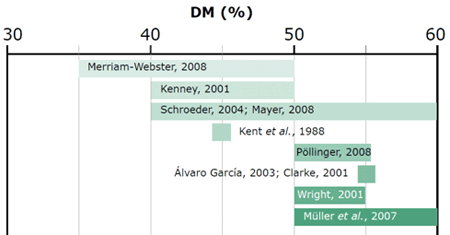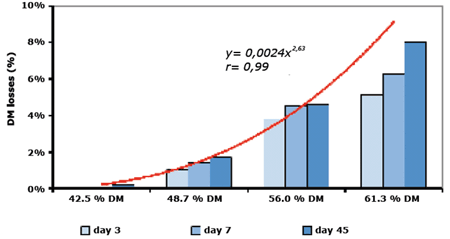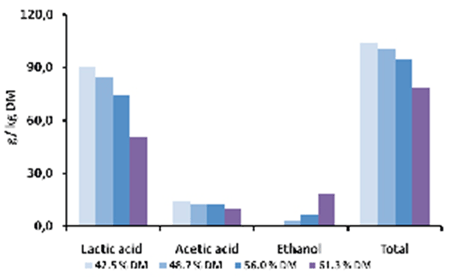Silage inoculants for haylage: feasible?
Published: March 9, 2009
By: Acosta Aragón, Y. (BIOMIN Holding GmbH) and Schoendorfer, K. (Technology Center Tulln) -Courtesy of Biomin GmbH
The preservation of feed for periods of underproduction is a universal problem. All farmers worldwide face the need of guaranteeing the feed for their animals over the year, and not only quantitatively but also qualitatively.
A first differentiation in the techniques used for preserving feed is done by the presence or lack of oxygen. Grains and hay are mainly preserved aerobically with the addition of different kinds of preservatives. A classic example for an anaerobic preservation technique is ensiling. Though ensiling will mainly be used to preserved voluminous feed, many other substrates including grains, by products like fish residues, wet distillery grains with solubles or WDGS, brewer´s grains, etc., can also be ensiled. The necessary pre- requisites are a) easily fermentable sugars, b) anaerobic conditions, c) lactic acid bacteria and d) factors allowing their proliferation like DM content and buffer capacity.
The DM content plays a big role in the fermentability of a substrate. This key point seems to be simple to guarantee but under practical conditions it is not. Due to different weather conditions it is a real challenge to harvest the crops at the adequate DM content. On the other hand, the bacteria and specifically the lactic acid bacteria (LAB) originating from the epiphytic microflora or silage inoculants are able to survive only under specific conditions, one of them is also the DM content, as it determines the osmotic pressure and the aw-value of the substrates. Different terms are used for materials undergoing an ensiling process. Silage, haylage, baleage? What is the difference between them? Are silage inoculants able to improve their fermentation quality and/ or the aerobic stability? The purpose of this article is to provide tools for the necessary differentiation, as well as to show results in the use of silage inoculants for haylage... but, what is haylage?
Silage inoculants for haylage: feasible?
What is haylage? If you take a look into the web, you will maybe have some kind of "info-xication", since the term "haylage" (English: haylage; German: Halbheu, Anwelkheu, Gärheu, Heulage; French: ensilage mi- fané, haylage; Italian: erba-silo, forragio semisecco; Spanish: henolaje; Russian: ?????) is cited very often.
Some authors define "haylage" as "... an alternative when weather conditions are not good enough for drying hay below 14 %..." (Kenney, 2001), "... a feed that is halfway between hay and silage (Saunders Comprehensive Veterinary Dictionary, 2007)" or "... ensiled forages, made up of grass, alfalfa and alfalfa- grass mixes (Wikipedia, 2008)"; whereas "baleage", also known as round bale silage, is "simply forage that is baled at a higher moisture content than dry hay and stored in sealed plastic wrap with 40 - 50 % DM" (Schroeder, 2004).
However, very often the terms are used indistinctly and there can be found affirmations like "round bale silage (a baleage) is also sometimes called haylage". Mayer (1999) considered baleage, big bale haylage and round bale silage as different names given to the same preserved feedstuff. Both processes are anaerobic but the first one (haylage) is related to the DM content at ensiling; and the second one (baleage) is the procedure used to protect the material against spoiling (baling, wrapping). That is the reason why we fully agree with Schroeder (2004) when he writes "wrapped haylage bales". Haylage may be preserved wrapped but also in other type of silos (bunker, trench, etc.).
Another controversial topic is the right DM content range for haylage. A review on this topic is shown in Figure 1.

Figure 1: DM content range for haylage according to different authors
The range varies from 35 to 60 % DM. Moreover, many companies produce haylage for horses and consider it as an especial feed type of wilted grass silage with 65 % DM.
For our purposes (use of silage inoculants in haylage for cattle) we will consider a range of 40 - 50 % DM, since below 40 % DM, it would be normal wilted silage, and over this range (55 % DM) the feed would be more adequate for horses due to the higher fiber content (see Figure 1).
Two aspects are very important to be taken into account: a) the high DM content is out of the optimal values for LAB and b) the whole material, due to the high DM content, is difficult to compact.
The procedure for making haylage follows the same step as silage making, only the wilting lasts longer until reaching the desired DM content. The advantages of the use of haylage are:
- Free from spores and dust (very important for horses!)
- Lower storage losses than in silage making (see figure 3 below)
- Weather independent when compared with hay making
- Higher density of nutrients per volumetric unit compared with silages
The storage and harvest losses with different moisture contents are given in Figure 2. Note that the sum of losses at a level between 60 and 50 % of moisture (40- 50 % DM) are minimal, which represents a great advantage in the use of haylage.

Figure 2: Estimated hay and haylage harvest and storage losses
(Adapted from OMAFRA STAFF, 2002)
(Adapted from OMAFRA STAFF, 2002)
While the stage of maturity increases, the crude protein (Figure 3a) decreases but the crude fiber (Figure 3b) content increases, which could be related with a lower feed intake and digestibility.

Figures 3 a and b: Crude protein (a, above) and crude fiber (b, below) content in 6 different annual grasses in different maturity stages (George and Bell, 2001)
According to Pöllinger (2008), the quality parameters for haylage are not strictly enough determined. A major aim in haylage making should be a decrease in the pH value below 5, the best below 4.5 to diminish the risk of botulism (Kenney, 2001; Wright, 2001) and listeriosis (Ryser and Marth., 2007). Since the DM is higher compared with that in silages, the production of fermentation products will be lower. Common values for lactic and acetic acid contents in haylage would be from 15 to 50, and less than 20 g/ kg DM respectively. The butyric acid and ethanol are as undesirable as in the silages. Due to the commonly slower acidification, some amount of one/ both of these substances can appear.
The use of silage inoculants in haylages should fulfill the same role as in the silage: quicker and deeper acidification and/ or enlarged aerobic stability. It would improve animal performance. For example, Kent et al. (1988), found a tendency towards higher DM intake (20.4 vs. 18.1 kg/ day) of cows in early lactation fed treated haylage (alfalfa haylage of 45 % DM; P < 0.32). The use of inoculants decreased the pH value from 5.29 vs. 5.11 for the control and the treated haylage.
The use of a silage inoculant for haylage in a laboratory trial
The aim of this trial was to find out how effective the haylage inoculation is with Biomin® BioStabil Plus by high DM contents. The experiment was conducted from May to August 2008 in the Technology Center of Tulln, Austria. The main parameters to measure the effectivity of the silage inoculants were: DM losses, acidification, fermentation products (HPLC) and aerobic stability (differences between room and silage temperature, considering a difference of 2 °C as unstable, according to Honing, 1990) in small-scale silos in the laboratory. The mini silos were kept below a temperature of ± 2 °C, and were opened after 3, 7, 45 and 90 days.
The DM contents varied between 42 and 61 % (4 treatments with 42, 49, 56 and 61 % of DM), which were reached using the same material and wilting it gradually in the sun. The inoculation rate was the same for all treatments (2 x 105 cfu/ g silage). Figure 4 shows the DM losses 90 days after ensiling. The DM losses were minimal when the DM content was close to 40 %, and increased continuously with increasing DM content and ensiling time from about 0 to 8 %. The tendency is well described by an exponential function (r = 0.99).

Figure 4: DM losses in the laboratory silages after 3, 7 and 45 days
The acidification of the silages was also affected by the DM content (Figure 5).

Figure 5: pH values of silages with different DM contents over a trial period of 90 days
After 7 days, the pH values for the treatments with 42 and 49 % DM were already deep enough (under 4.5) to guarantee an anaerobically stable silage for this DM content (Kaiser, 2006) and stop the growth of the Clostridia (Kenney, 2001). The treatments with 56 and 61 % of DM had at this time a pH of 4.7- 4.8 and 5.5 respectively, which could be considered as adequate for the first but not for the second treatment. The 56 % DM treatment reached pH of 4.5 sometime between 7 and 45 days after ensiling and kept under this value up to the end to the trial. The driest silage reached a pH of 4.5 first after 45 days and always remained around this value. The logical conclusion, coincident with many scientific publications (Whiter and Kung, 2001; Jones et al., 1992; Muck, 1990), is a positive correlation between the DM content and the pH value. In spite of the relatively high pH values of the 61 % DM treatment compared with other treatments, there was an existing fermentation, which proved the activity of the product strains.
The acidification correlates very well (positively) with the lactic acid contents, as can be seen in Figure 6.

Figure 6: Fermentation products in the silages 90 days after ensiling
The increasing DM content reduced not only the amount of lactic acid but also the total amount of fermentation products. The opposite tendency can be seen in the ethanol content: the higher the DM, the higher the ethanol content. This parameter can be related with the presence of yeasts in the silages due to bad compacting.
The aerobic stability was shorter only for the treatment with 61.3 % of DM (5.58 vs. 6.69 days). Summarizing, the best results were reached when the DM was around 40 %, the upper optimal limit for the grass DM level at harvest for silage (DLG, 2006). In case of optimal DM contents for haylage (40 - 50 %) the risk of:
- DM losses
- ethanol contents and
- insufficient aerobic stability
is reduced.
Nevertheless, the differences regarding fermentation and aerobic stability between the treatments with 42 and 49 % were very small. The differences between these two groups with the treatment with 56 % were not very marked regarding aerobic stability, however, the fermentation (pH decrease and fermentation products) was slower. The acidification in the treatment with 61 % of DM was negatively affected by the high DM content, in the first week almost not existing. The aerobic stability in this treatment was also shorter.
On the basis of these laboratory results, it is recommended not to surpass 50 - 55 % of DM. Biomin® BioStabil Plus is able to fermentate adequately up to this DM content with the normal dosage (2 x 105 cfu/ g silage).
The use of a silage inoculants for haylage in a field trial
A trial under practical conditions was conducted in the farm Vorbuse, in Estonia, in the silage season 2006. The ensiled material was grass from the first cut (49.6 % of DM, 12.8 % crude protein, 8.81 % ash). The grass was inoculated with the product Biomin® BioStabil Plus, in a dosage of 4 g/ ton, which guarantees a concentration of 2 x 105 cfu/ g silage. The dosage per ton was dissolved in 1 liter water. The silo was a bunker silo with a capacity of 1500 tons. Six weeks after ensiling, subsamples of 400 - 500 g were well mixed and 2- 3 kg of the mix was placed in a sample bag. After sampling the air was squeezed out of the bag manually, sealed tightly, clearly labeled and immediately sent to a local, independent laboratory.
The DM content (49.6 %) was higher than usual for silages, but normal for haylage according to the above cited references. The ash content did not surpass the limit of 9 - 10 %. Table 1 shows the nutrient and energy content of the haylage, as well as the fermentation parameters, compared with the normal contents given by the DLG (2006) for silages.
Parameters | Silage | Optimal for silages |
Dry matter (%) | 43.7 | 30- 40 |
Crude protein (% in DM) | 13.00 | 14- 16 |
Ash (% in DM) | 8.90 | 9 -10 |
ME (MJ/kg DM) | 9.7 | 9.7- 10.1 |
pH | 4.6 | 4.9- 5.0 |
Lactic acid (% in DM) | 4.94 | |
Acetic acid (% in DM) | 1.58 | 2.0- 3.5 |
Butyric acid (% in DM) | 0.00 | < 0.3 |
Propionic acid (% in DM) | 0.02 |
Table 1: Characteristics of the haylage treated with Biomin® BioStabil Plus compared to recommended levels for silage
Conclusions
The use of haylage for the feeding of cattle represents an interesting alternative because:
- reduces the losses,
- represents a less weather conditions dependent method compared with hay, and
- is a more concentrated feedstuff than silage.
Silage inoculants are capable of improving the quality of haylage, lowering DM losses and pH value, as well as ethanol content, and enlarging the aerobic stability.
Biomin® BioStabil Plus proved its efficacy as a silage inoculant, even under very high DM contents.
Literature
- DLG (German Association for Agriculture) (2006)
- García, A.; Thiex, N.; Kalscheur, K. and Tjardes, K. (2003)
- George, M. R. and Bell M. E. (2001)
- Kaiser, E. (2006)
- Kenney, D. (2001)
- Kent, B. A.; Arambel, M. J. and Walters, J. L. (1988)
- Mayer, R. (1999)
- Merriam-Webster (2008)
- Müller, C. E.; Möller, J.; Krogh Jensen, S. and Uden, P. (2007)
- OMAFRA Staff (2002)
- Pöllinger, A. (2008)
- Ryser, E. T. and Marth, E. H. (2007)
- Saunders Comprehensive Veterinary Dictionary (3rd edition, 2007)
- Schroeder, J. W. (2004)
- Whiter, A. G. and Kung, L. Jr. (2001)
- wikipedia (2008)
Related topics:
Authors:
DSM-Firmenich
Recommend
Comment
Share

Would you like to discuss another topic? Create a new post to engage with experts in the community.






.jpg&w=3840&q=75)